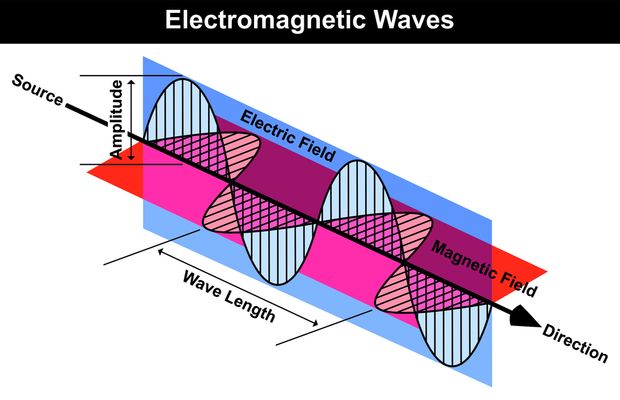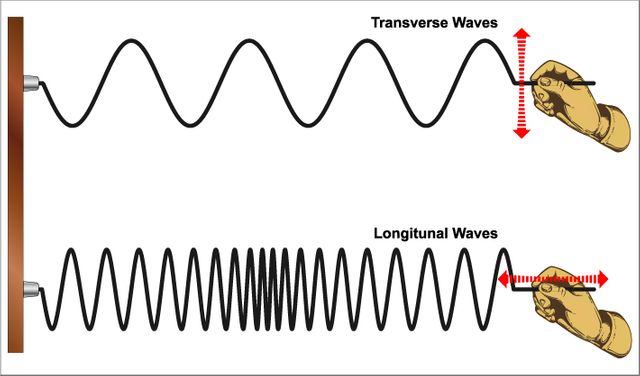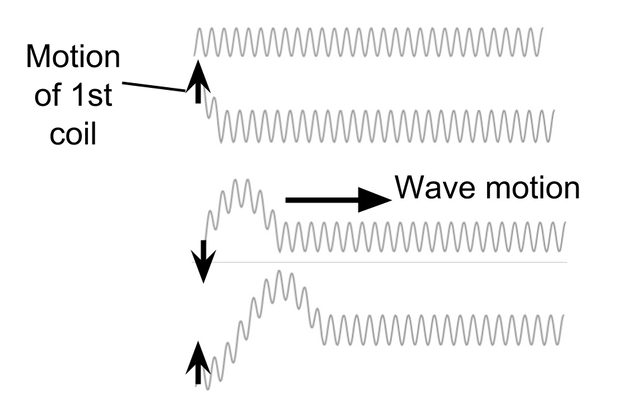3.1.5
Polarisation
Polarised Light
Polarised Light
Polarised light only vibrates in one plane.


Polarisation direction
Polarisation direction
- Imagine holding a rope and shaking it so it forms a transverse wave.
- If you shake the rope from left to right (horizontally) you will form waves that are horizontally-plane polarised.
- This is because the wave lies in the horizontal plane.


Polarisation direction 2
Polarisation direction 2
- If you shake the rope up and down (vertically) you will form waves that are vertically-plane polarised.
- This is because the wave lies in the vertical plane.
- These are two possible polarisation directions.
- You can have a whole range of polarisation directions: all the angles from 0° to 360°, not just left-right and up-down.


Evidence for the transverse nature of waves
Evidence for the transverse nature of waves
- Longitudinal waves cannot be polarised.
- If a wave can be polarised, that must mean that the wave is transverse.
Applications of Polarisations
Applications of Polarisations
Polarisers only allow transverse waves at particular angles to pass through. This is useful for sunglasses and television transmission and reception.


Polarisers
Polarisers
- Polarisers only allow transverse waves at particular angles to pass through.


Polaroid material
Polaroid material
- An example of a polariser is Polaroid material. This is used in sunglasses.
- Sunlight is unpolarised.
- The vibrations in the electric and magnetic fields are at all polarisation directions possible.
- If we saw a beam head-on we would see all the polarisation directions.


Polaroid material 2
Polaroid material 2
- Polaroid sheets are made of long molecules of quinine iodosulphate.
- The molecules run up and down the sheet.
- Any polarisation direction that is parallel to the molecules is absorbed.
- Any polarisation direction that is perpendicular to the molecules is transmitted.
- The transmitted light is at a lower intensity.


Reflection as polarisation
Reflection as polarisation
- When unpolarised light reflects off a transparent surface, the light becomes polarised.
- The polarisation is partial and parallel to the surface.


Polarisers at right angles
Polarisers at right angles
- If two polarisers, like Polaroid sheets, were placed at right angles to each other, no light would be able to get through.
- The first Polaroid would transmit only horizontally polarised light. But the second Polaroid can only transmit vertically polarised light.
- The incoming horizontally polarised light will be completely absorbed by the second Polaroid.


Aerials for transmission and reception
Aerials for transmission and reception
- A television or radio aerial can either be orientated so its spokes are vertical or horizontal.
- If a transmitter sends out a vertically polarised electromagnetic wave, the spokes on the aerial must also be aligned vertically.
- This is because maximum absorption of the vertically polarised wave is needed to get a good signal.
1Measurements & Errors
1.1Measurements & Errors
1.1.1SI Base Units
1.1.2Combining SI Units
1.1.3Prefixes of Units
1.1.4Standard Form
1.1.5Converting Units
1.1.6End of Topic Test - Units & Prefixes
1.1.7Limitation of Physical Measurements
1.1.8Uncertainty
1.1.9Estimation
1.1.10End of Topic Test - Measurements & Errors
1.1.11Diagnostic Misconceptions - Converting between SI
1.1.12Diagnostic Misconceptions - SI & Area/Volume
2Particles & Radiation
2.1Particles
2.1.1Atomic Model
2.1.2Specific Charge, Protons & Neutron Numbers
2.1.3End of Topic Test - Atomic Model
2.1.4Isotopes
2.1.5Stable & Unstable Nuclei
2.1.6End of Topic Test - Isotopes & Nuclei
2.1.7A-A* (AO3/4) - Stable & Unstable Nuclei
2.1.8Particles, Antiparticles & Photons
2.1.9Particle Interactions
2.1.10Classification of Particles
2.1.11End of Topic Test - Particles & Interactions
2.1.12Quarks & Antiquarks
2.1.13Application of Conservation Laws
2.1.14End of Topic Test - Leptons & Quarks
2.1.15Exam-Style Question - Radioactive Decay
2.2Electromagnetic Radiation & Quantum Phenomena
2.2.1The Photoelectric Effect
2.2.2The Photoelectric Effect Explanation
2.2.3End of Topic Test - The Photoelectric Effect
2.2.4Collisions of Electrons with Atoms
2.2.5Energy Levels & Photon Emission
2.2.6Wave-Particle Duality
2.2.7End of Topic Test - Absorption & Emission
2.2.8Diagnostic Misconceptions - Electron Volts
2.2.9Diagnostic Misconceptions - Converting eV & Joules
3Waves
3.1Progressive & Stationary Waves
3.2Refraction, Diffraction & Interference
4Mechanics & Materials
4.1Force, Energy & Momentum
4.1.1Scalars & Vectors
4.1.2Vector Problems
4.1.3End of Topic Test - Scalars & Vectors
4.1.4Moments
4.1.5Centre of Mass
4.1.6End of Topic Test - Moments & Centre of Mass
4.1.7Motion in a Straight Line
4.1.8Graphs of Motion
4.1.9Bouncing Ball Example
4.1.10End of Topic Test - Motion in a Straight Line
4.1.11Acceleration Due to Gravity
4.1.12Projectile Motion
4.1.13Friction
4.1.14Terminal Speed
4.1.15End of Topic Test - Acceleration Due to Gravity
4.1.16Newton's Laws
4.1.17Momentum
4.1.18Momentum 2
4.1.19End of Topic Test - Newton's Laws & Momentum
4.1.20A-A* (AO3/4) - Newton's Third Law
4.1.21Work & Energy
4.1.22Power & Efficiency
4.1.23Conservation of Energy
4.1.24End of Topic Test - Work, Energy & Power
4.1.25Exam-Style Question - Forces
4.1.26Diagnostic Misconceptions - Perpendicular Vectors
4.1.27Diagnostic Misconceptions - Weight Acts Downwards
4.1.28Diagnostic Misconceptions - Acceleration Direction
4.1.29Diagnostic Misconceptions - Stationary Objects
4.1.30Diagnostic Misconceptions - Action & Reaction
4.1.31Diagnostic Misconceptions - RF Direction
4.1.32Diagnostic Misconceptions - RF Acceleration
4.1.33Diagnostic Misconceptions - Change in Momentum
5Electricity
5.1Current Electricity
5.1.1Basics of Electricity
5.1.2Current-Voltage Characteristics
5.1.3End of Topic Test - Basics of Electricity
5.1.4Resistivity
5.1.5Superconductivity
5.1.6A-A* (AO3/4) - Superconductivity
5.1.7End of Topic Test - Resistivity & Superconductors
5.1.8Circuits
5.1.9Power and Conservation
5.1.10Potential Divider
5.1.11Emf & Internal Resistance
5.1.12End of Topic Test - Power & Potential
5.1.13Exam-Style Question - Resistance
5.1.14Diagnostic Misconceptions - Constant Current
5.1.15Diagnostic Misconceptions - Potential Difference
6Further Mechanics & Thermal Physics (A2 only)
6.1Periodic Motion (A2 only)
6.2Thermal Physics (A2 only)
6.2.1Thermal Energy Transfer
6.2.2Thermal Energy Transfer Experiments
6.2.3Ideal Gases
6.2.4Ideal Gases 2
6.2.5Boyle's Law & Charles' Law
6.2.6Molecular Kinetic Theory Model
6.2.7Molecular Kinetic Theory Model 2
6.2.8End of Topic Test - Thermal Energy & Ideal Gases
6.2.9Exam-Style Question - Ideal Gases
6.2.10Diagnostic Misconceptions - Material & Mass
6.2.11Diagnostic Misconceptions - No Energy
7Fields & Their Consequences (A2 only)
7.1Fields (A2 only)
7.2Gravitational Fields (A2 only)
7.3Electric Fields (A2 only)
7.4Capacitance (A2 only)
7.5Magnetic Fields (A2 only)
7.5.1Magnetic Flux Density
7.5.2End of Topic Test - Capacitance & Flux Density
7.5.3Moving Charges in a Magnetic Field
7.5.4Magnetic Flux & Flux Linkage
7.5.5Electromagnetic Induction
7.5.6Electromagnetic Induction 2
7.5.7Alternating Currents
7.5.8Operation of a Transformer
7.5.9Magnetic Flux Density
7.5.10End of Topic Test - Electromagnetic Induction
8Nuclear Physics (A2 only)
8.1Radioactivity (A2 only)
8.1.1Rutherford Scattering
8.1.2Alpha & Beta Radiation
8.1.3Gamma Radiation
8.1.4Radioactive Decay
8.1.5Half Life
8.1.6End of Topic Test - Radioactivity
8.1.7Nuclear Instability
8.1.8Nuclear Radius
8.1.9Mass & Energy
8.1.10Binding Energy
8.1.11Induced Fission
8.1.12Safety Aspects of Nuclear Reactors
8.1.13End of Topic Test - Nuclear Physics
8.1.14A-A* (AO3/4) - Nuclear Fusion
9Option: Astrophysics (A2 only)
9.1Telescopes (A2 only)
9.2Classification of Stars (A2 only)
9.3Cosmology (A2 only)
10Option: Medical Physics (A2 only)
10.1Physics of the Eye (A2 only)
10.2Physics of the Ear (A2 only)
10.3Biological Measurement (A2 only)
10.4Non-Ionising Imaging (A2 only)
10.5X-Ray Imaging (A2 only)
10.6Radionuclide Imaging & Therapy (A2 only)
11Option: Engineering Physics (A2 only)
11.1Rotational Dynamics (A2 only)
11.2Thermodynamics & Engines (A2 only)
12Option: Turning Points in Physics (A2 only)
12.1Discovery of the Electron (A2 only)
12.2Wave-Particle Duality (A2 only)
Jump to other topics
1Measurements & Errors
1.1Measurements & Errors
1.1.1SI Base Units
1.1.2Combining SI Units
1.1.3Prefixes of Units
1.1.4Standard Form
1.1.5Converting Units
1.1.6End of Topic Test - Units & Prefixes
1.1.7Limitation of Physical Measurements
1.1.8Uncertainty
1.1.9Estimation
1.1.10End of Topic Test - Measurements & Errors
1.1.11Diagnostic Misconceptions - Converting between SI
1.1.12Diagnostic Misconceptions - SI & Area/Volume
2Particles & Radiation
2.1Particles
2.1.1Atomic Model
2.1.2Specific Charge, Protons & Neutron Numbers
2.1.3End of Topic Test - Atomic Model
2.1.4Isotopes
2.1.5Stable & Unstable Nuclei
2.1.6End of Topic Test - Isotopes & Nuclei
2.1.7A-A* (AO3/4) - Stable & Unstable Nuclei
2.1.8Particles, Antiparticles & Photons
2.1.9Particle Interactions
2.1.10Classification of Particles
2.1.11End of Topic Test - Particles & Interactions
2.1.12Quarks & Antiquarks
2.1.13Application of Conservation Laws
2.1.14End of Topic Test - Leptons & Quarks
2.1.15Exam-Style Question - Radioactive Decay
2.2Electromagnetic Radiation & Quantum Phenomena
2.2.1The Photoelectric Effect
2.2.2The Photoelectric Effect Explanation
2.2.3End of Topic Test - The Photoelectric Effect
2.2.4Collisions of Electrons with Atoms
2.2.5Energy Levels & Photon Emission
2.2.6Wave-Particle Duality
2.2.7End of Topic Test - Absorption & Emission
2.2.8Diagnostic Misconceptions - Electron Volts
2.2.9Diagnostic Misconceptions - Converting eV & Joules
3Waves
3.1Progressive & Stationary Waves
3.2Refraction, Diffraction & Interference
4Mechanics & Materials
4.1Force, Energy & Momentum
4.1.1Scalars & Vectors
4.1.2Vector Problems
4.1.3End of Topic Test - Scalars & Vectors
4.1.4Moments
4.1.5Centre of Mass
4.1.6End of Topic Test - Moments & Centre of Mass
4.1.7Motion in a Straight Line
4.1.8Graphs of Motion
4.1.9Bouncing Ball Example
4.1.10End of Topic Test - Motion in a Straight Line
4.1.11Acceleration Due to Gravity
4.1.12Projectile Motion
4.1.13Friction
4.1.14Terminal Speed
4.1.15End of Topic Test - Acceleration Due to Gravity
4.1.16Newton's Laws
4.1.17Momentum
4.1.18Momentum 2
4.1.19End of Topic Test - Newton's Laws & Momentum
4.1.20A-A* (AO3/4) - Newton's Third Law
4.1.21Work & Energy
4.1.22Power & Efficiency
4.1.23Conservation of Energy
4.1.24End of Topic Test - Work, Energy & Power
4.1.25Exam-Style Question - Forces
4.1.26Diagnostic Misconceptions - Perpendicular Vectors
4.1.27Diagnostic Misconceptions - Weight Acts Downwards
4.1.28Diagnostic Misconceptions - Acceleration Direction
4.1.29Diagnostic Misconceptions - Stationary Objects
4.1.30Diagnostic Misconceptions - Action & Reaction
4.1.31Diagnostic Misconceptions - RF Direction
4.1.32Diagnostic Misconceptions - RF Acceleration
4.1.33Diagnostic Misconceptions - Change in Momentum
5Electricity
5.1Current Electricity
5.1.1Basics of Electricity
5.1.2Current-Voltage Characteristics
5.1.3End of Topic Test - Basics of Electricity
5.1.4Resistivity
5.1.5Superconductivity
5.1.6A-A* (AO3/4) - Superconductivity
5.1.7End of Topic Test - Resistivity & Superconductors
5.1.8Circuits
5.1.9Power and Conservation
5.1.10Potential Divider
5.1.11Emf & Internal Resistance
5.1.12End of Topic Test - Power & Potential
5.1.13Exam-Style Question - Resistance
5.1.14Diagnostic Misconceptions - Constant Current
5.1.15Diagnostic Misconceptions - Potential Difference
6Further Mechanics & Thermal Physics (A2 only)
6.1Periodic Motion (A2 only)
6.2Thermal Physics (A2 only)
6.2.1Thermal Energy Transfer
6.2.2Thermal Energy Transfer Experiments
6.2.3Ideal Gases
6.2.4Ideal Gases 2
6.2.5Boyle's Law & Charles' Law
6.2.6Molecular Kinetic Theory Model
6.2.7Molecular Kinetic Theory Model 2
6.2.8End of Topic Test - Thermal Energy & Ideal Gases
6.2.9Exam-Style Question - Ideal Gases
6.2.10Diagnostic Misconceptions - Material & Mass
6.2.11Diagnostic Misconceptions - No Energy
7Fields & Their Consequences (A2 only)
7.1Fields (A2 only)
7.2Gravitational Fields (A2 only)
7.3Electric Fields (A2 only)
7.4Capacitance (A2 only)
7.5Magnetic Fields (A2 only)
7.5.1Magnetic Flux Density
7.5.2End of Topic Test - Capacitance & Flux Density
7.5.3Moving Charges in a Magnetic Field
7.5.4Magnetic Flux & Flux Linkage
7.5.5Electromagnetic Induction
7.5.6Electromagnetic Induction 2
7.5.7Alternating Currents
7.5.8Operation of a Transformer
7.5.9Magnetic Flux Density
7.5.10End of Topic Test - Electromagnetic Induction
8Nuclear Physics (A2 only)
8.1Radioactivity (A2 only)
8.1.1Rutherford Scattering
8.1.2Alpha & Beta Radiation
8.1.3Gamma Radiation
8.1.4Radioactive Decay
8.1.5Half Life
8.1.6End of Topic Test - Radioactivity
8.1.7Nuclear Instability
8.1.8Nuclear Radius
8.1.9Mass & Energy
8.1.10Binding Energy
8.1.11Induced Fission
8.1.12Safety Aspects of Nuclear Reactors
8.1.13End of Topic Test - Nuclear Physics
8.1.14A-A* (AO3/4) - Nuclear Fusion
9Option: Astrophysics (A2 only)
9.1Telescopes (A2 only)
9.2Classification of Stars (A2 only)
9.3Cosmology (A2 only)
10Option: Medical Physics (A2 only)
10.1Physics of the Eye (A2 only)
10.2Physics of the Ear (A2 only)
10.3Biological Measurement (A2 only)
10.4Non-Ionising Imaging (A2 only)
10.5X-Ray Imaging (A2 only)
10.6Radionuclide Imaging & Therapy (A2 only)
11Option: Engineering Physics (A2 only)
11.1Rotational Dynamics (A2 only)
11.2Thermodynamics & Engines (A2 only)
12Option: Turning Points in Physics (A2 only)
12.1Discovery of the Electron (A2 only)
12.2Wave-Particle Duality (A2 only)
Unlock your full potential with Seneca Premium
Unlimited access to 10,000+ open-ended exam questions
Mini-mock exams based on your study history
Unlock 800+ premium courses & e-books